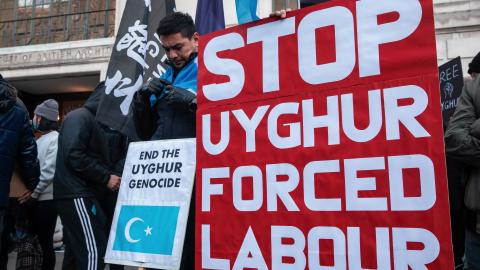It all starts with a knock at the door. That knock is no friendly neighbor. Instead, it’s an invitation by a Chinese official to a Uyghur to join a government work program. It’s an offer Uyghurs cannot refuse. Not because the pay or job is too enticing, but because their future (as well as their life and livelihood) may depend on it.
This is a scenario described in Ian Urbina’s recent report for the New Yorker on Uyghurs forced to labor in China’s extensive seafood industry. The report is groundbreaking because it reveals a significant blind spot in U.S. efforts to thwart goods produced with Uyghur forced labor from entering U.S. markets.
The seafood industry is big business, constituting approximately $140 billion in trade annually. According to testimony from Sally Yozell, Senior Fellow and Director of the Environmental Security program at Stimson Center, in 2022 alone, the U.S. imported over $30 billion in seafood. And Yozell reports that just under 40 percent of U.S. imports of seafood, despite originating in the U.S., are processed in China. Urbina’s report puts a finer point on it, saying that over the past five years, the U.S. has imported more than $200 million in seafood from entities whose production line is likely tainted by Uyghur forced labor.
Urbina’s investigation was extensive. Video evidence, Chinese government documents, and investigative visits to seafood industry factories uncovered the true nature of Uyghurs forced to labor in the seafood sector. The investigations revealed the coercive nature of the labor transfer programs, meager wages, limited-to-no freedom of movement, lengthy work hours, and squalid conditions.
To make matters worse, Uyghurs who refuse labor transfers (not specific only to the seafood industry) are often sent to detention facilities or the political reeducation camps known to house between 1 million and 2 million Uyghurs. A new report by Adrian Zenz, Senior Fellow and Director of China Studies at the Victims of Communism Memorial Foundation, meticulously documents these revelations.
Zenz notes that, “The evidence consists of a combination of new internal state documents and witness accounts and provides the first conclusive evidence that Uyghurs who refused state work assignments were placed into re-education camps. This shows the pervasive coercive force of state-imposed forced labor in the region, which is affecting many more supply chains than we knew.”
Awareness about Uyghur forced labor is relatively high. So high, in fact, that the U.S. Congress passed the Uyghur Forced Labor Prevention Act (UFLPA) signed into law in December 2021 and implemented in June 2022. The UFLPA created a rebuttable presumption stating that all goods produced “wholly or in part” with Uyghur forced labor are barred from entering U.S. markets. The law put the burden on business to prove a negative – that goods they import from China are not tainted by Uyghur forced labor.
The UFLPA has only been in effect for a little over a year and a half. In that timeframe, Customs and Border Protection (CBP) has apprehended nearly $2 billion in suspected goods produced with Uyghur forced labor as of October 2023; of that amount, only a little over $500 million have conclusively been found to be produced with Uyghur forced labor, with other shipments pending review. CBP has focused on several sectors, including apparel and footwear, agricultural goods and products, electronics, and others that are known to be high-risk for Uyghur forced labor. After the recent revelations, it will likely need to add seafood to that list.
In addition to more closely monitoring key and emerging sectors where Uyghurs are exploited, Zenz suggests that “Implicated Chinese companies should immediately be placed on the entities list.” If included on the UFLPA Entity List, the entities listed are subject to the UFLPA’s rebuttable presumption.
New revelations about the seafood sector serve as an important reminder that the mere passage of the UFLPA is not enough to end Uyghur forced labor. Instead, the U.S. must continue to beef up enforcement of UFLPA provisions, stay on the cutting edge of identifying new sectors at risk of Uyghur forced labor, and also include other countries around the globe in efforts to end the enslavement of the Uyghur people.




















